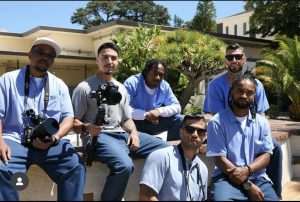
Some members of the San Quentin News crew
I became fascinated by the American criminal and justice systems as a teenager, thanks to my sister Raliya who introduced me to the books of lawyer turned writer John Grisham. My sister was a law student, so she was understandably into books with legal themes. For me on the other hand, I was intrigued by the storylines and the characters intrigued me.
They were all so alien yet fascinating and incredibly exciting to read. In Grisham’s books I learned how the jury system works. I also learned who a paralegal, a prosecutor and a district attorney were, I understood the strategies of choosing jurors by both sides of the case, I understood what it meant to get a life sentence and to be on death row.
So when on a cold Monday morning in San Francisco we drove north to the San Quentin State Prison for men, I was thrilled. I was going to see first hand the people that make up the stories I have read about. The prison is described as “the oldest, most notorious prison in Carlifornia” and has the largest death row in the United States. As I rode in the car, visions of John Grisham’s “The Brethren” mixed with images from the 2005 drama “Prison Break” drama series kept running through my mind. I was sure I would see violent-looking men sitting aimlessly in orange or gray jumpsuits gawking at us as we moved through prison corridors. But I was wrong.
In San Quentin, I met men who were working hard to turn their lives around. Men who understood the consequences of what they had done and were striving to break the stigma of incarceration.
The three tour guides took us around the faciliy, as part of the team for Lt. Guim’Mara Berry, the prison’s public information officer. The guides were part of the prison population all there for different offences. One of them was Timothy Higgs, a middle aged black man whom I would later start a conversation with. A loud warning siren would interrupt that conversation, prompting Higgs and his fellow inmates to “lay -low.” We learned there was a scuffle between an inmate and a security guard somewhere on the facility. He didn’t seem to be fazed at all as he happily but solemnly told me he is set to be released in December. Later, I read about his case and learn that he was incarcerated for the voluntary manslaughter of two people in 2006.
San Quentin is a unique prison. It has a full-working newsroom that monthly produces a remarkable 35,000 copies of the San Quentin News – a newspaper written and produced primarily by people who are incarcerated and distributed to prisons, juvenile facilities and public libraries. They also have a news website, a newsletter and a podcast with over eight million downloads. This news agency has an editor -in -chief, senior editors, reporters, writers, photographers and videographers. Higgs is the sports editor. Most of them trained in journalism at the prison They are paid 50 cents to a dollar an hour for their work.I was in awe of how passionate and hopeful they were about the work they produce. This is an initiative to prepare incarcerated people for life after prison.
My assumptions about people who are incarcerated vanished instantly and I saw them in a totally different light. One of the journalists said: “I may never get out of here, because I got 250 years, but at least I am doing something with my life, something that I love. If I ever get out, I want to be a filmmaker, but I also want to be a movie director.”



